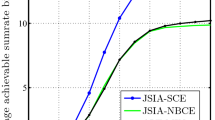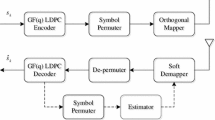Abstract
The accuracy of channel state information (CSI) available at a base station (BS) has a direct impact on the performance of precoding in wideband multi-user multiple input, multiple output-orthogonal frequency division multiplexing (MIMO-OFDM) systems and depends on many factors, including: the delay between estimation and beamforming at the BS (also called the CSI delay), Doppler spread, the channel estimation method used, the average transmit power of pilot symbols, and the average number of pilot symbols that must be estimated per channel parameter. In this paper, the coefficient of CSI error needed to adapt to fading channels is modeled as a function of Doppler spread, CSI delay, and signal-to-noise ratio (SNR). In terms of the Gaussian-Markov CSI error model, an adaptive robust maximum signal-to-leakage-and-noise ratio (Max- SLNR) precoder is designed to track the statistical parameters of CSI error. The Doppler spread and SNR can be obtained through real-time estimation based on orthogonal pilot patterns. Simulation results show that, compared to non-adaptive robust and non-robust precoders of Max-SLNR, the proposed adaptive robust Max- SLNR precoder performs much better in terms of bit error rate (BER). Moreover, as either the average number of training symbols per channel parameter or the average transmit power increases, the BER performance of the proposed precoder approaches that of a precoder with ideal CSI.
摘要
在宽带多用户MIMO-OFDM系统中,基站获得的信道状态信息会受到延时、多普勒扩展、信道估计方法、导频符号发射功率及每信道参数必须估计的导频符号数目的影响,基站获得的信道状态信息的精确性会直接影响预编码算法的性能。本文中,我们将信道状态信息误差模型系数建模为与多普勒扩展,时延和信噪比有关的函数。基于高斯马尔科夫信道状态信息误差模型提出了一个自适应稳健的最大化信泄噪比的预编码算法来实时跟踪信道状态信息估计误差的统计特性的变化。通过基于正交导频模式的实时估计可以获得多普勒扩展和信噪比,从而实时估计误差模型系数。仿真表明:提出的自适应稳健的Max-SLNR预编码算法误码率性能明显优于非自适应和非稳健的算法,稳健性强;随着导频符号数目或发射功率的增加,提出的预编码算法的误码率性能会逐步逼近完美信道状态信息下的性能
Similar content being viewed by others
References
Gesbert D, Hanly S, Huang H, et al. Multi-cell MIMO cooperative networks: a new look at interference. IEEE Sel Area Commun, 2010, 28: 1380–1408
Chen R H, Geirhofer S, Sayana K, et al. Downlink MIMO in LTE-advanced: SU-MIMO vs MU-MIMO. IEEE Commun Mag, 2012, 50: 140–147
Karaa H, Adve R S, Tenenbaum A J. Linear precoding for multiuser MIMO-OFDM systems. In: IEEE International Conference on Communications (ICC), Glasgow, 2007. 2797–2802
Wang J, Xie X, Zhang Q. A way to reduce ICI for multi-user MIMO-OFDM system with precoding. In: IEEE International Conference on Advanced Computer Control, Singapore, 2009. 134–137
Shin Y, Kang T, Kim H. An efficient resource allocation for multiuser MIMO-OFDM systems with zero-forcing beamformer. In: IEEE International Symposium on Personal, Indoor and Mobile Radio Commun, Athens, 2007. 1–5
Castanheira D, Silva A, Gameiro A. Linear and nonlinear precoding schemes for centralized multicell MIMO-OFDM systems. IEEE Wirel Pers Commun, 2013, 72: 759–777
Sadek M, Aissa S. Leakage based precoding for multi-user MIMO-OFDM systems. IEEE Trans Wirel Commun, 2011, 10: 2428–2433
Sung H, Lee S R, Lee I. Generalized channel inversion methods for multiuser MIMO systems. IEEE Trans Commun, 2009, 57: 3489–3499
Liu W, Yang L L, Hanzo L. SVD-assisted multiuser transmitter and multiuser detector design for MIMO systems. IEEE Trans Veh Technol, 2009, 58: 1016–1021
Mao J L, Gao J C, Liu Y A, et al. Robust multiuser MIMO scheduling algorithms with imperfect CSI. Sci China Inf Sci, 2012, 55: 815–826
Zhou B, Jiang L, Zhang L, et al. Impact of imperfect channel state information on TDD downlink multiuser MIMO system. In: Proceedings of IEEE Wirel Commun and Networking Conference (WCNC), Cancun, 2011. 1823–1828
Wang C, Au E K S, Murch R D, et al. On the performance of the MIMO zero-forcing receiver in the presence of channel estimation error. IEEE Trans Wirel Commun, 2007, 6: 805–810
Sadek M, Tarighat A, Sayed A H. A leakage-based precoding scheme for downlink multi-user MIMO channels. IEEE Trans Wirel Commun, 2007, 6: 1711–1721
Chung P J, Du H. Robust SLNR downlink beamforming based on Markov’s inequality. In: IEEE International Conference on Communications (ICC), Ottawa, 2012. 3627–3631
Chung P J, Du H, Chen M. Robust transmit beamforming for multi-user MIMO systems using a probabilistic constraint approach. In: Signal Processing of 11th International Conference. Beijing: IEEE, 2012, 2: 1482–1485
Shen H, Xu W, Jin S, et al. Joint transmit and receive beamforming for multiuser MIMO downlinks with channel uncertainty. IEEE Trans Veh Technol, 2014, 63: 2319–2335
Merline A, Thiruvengadam S J. Design of optimal linear precoder and decoder for MIMO channels with per antenna power constraint and imperfect CSI. IEEE Wirel Pers Commun, 2014, 75: 1251–1263
Khalid F, Speidel J. Robust hybrid precoding for multiuser MIMO wireless communication systems. IEEE Trans Wirel Commun, 2014, 13: 1–11
Tseng F, Wang Y, Hsu C, et al. Robust tomlinson-harashima precoder design with random vector quantization in MIMO systems. IEEE Commun Lett, 2014, 18: 265–268
Sun Y, Wu M, Guo Q, et al. Robust non-linear precoder for multiuser MISO systems based on delay and channel quantization. Wirel Pers Commun, 2013, 72: 1993–2014
Pan C, Su C, Chen M. Robust precoding for multicell MIMO downlink systems. In: IEEE International Conference on Wireless Communications and Signal Processing (WCSP), Hangzhou, 2013. 1–6
Shu F, Lu Y Z, Chen Y. High-sum-rate beamformers for multi-pair two-way relay networks with amplify-and-forward relaying strategy. Sci China Inf Sci, 2014, 57: 022312
Wang J, Wen O Y, Li S. Soft-output MMSE MIMO detector under imperfect channel estimation. In: IEEE Wirel Commun and Networking Conference, Las Vegas, 2008. 1334–1338
Cai J P, Song W T, Li Z. Doppler spread estimation for mobile OFDM systems in rayleigh fading channels. IEEE Trans Consum Electron, 2003, 49: 973–977
Tepedelenlioglu C, Giannakis G. On velocity estimation and correlation properties of narrow-band mobile communication channels. IEEE Trans Veh Technol, 2001, 50: 1039–1052
Ijaz A, Awoseyila A B, Evans B G. Low-complexity time-domain SNR estimation for OFDM systems. IEEE Electron Lett, 2011, 47: 1154–1156
Li Y, Xu X, Zhang D D, et al. Optimal pilots design for frequency offsets and channel estimation in OFDM modulated single frequency networks. Sci China Inf Sci, 2014, 57: 042301
Author information
Authors and Affiliations
Corresponding author
Rights and permissions
About this article
Cite this article
Shu, F., Tong, J., You, X. et al. Adaptive robust Max-SLNR precoder for MU-MIMO-OFDM systems with imperfect CSI. Sci. China Inf. Sci. 59, 062302 (2016). https://doi.org/10.1007/s11432-015-5390-y
Received:
Accepted:
Published:
DOI: https://doi.org/10.1007/s11432-015-5390-y




